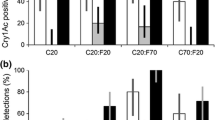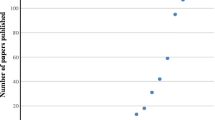Abstract
Selecting an appropriate invertebrate assay has been a primary goal of national and international testing programs for endocrine disrupting chemicals. The available information on the endocrine system, its hormones and their modes of action in controlling physiological processes in invertebrates is limited and the selection of appropriate test species still presents a challenge. This paper outlines the development of a higher-tier full life cycle (FLC) test for pesticides with the non-biting midge Chironomus riparius (Insecta, Diptera, Chironomidae). As an insect, C. riparius represents the species’ richest and ecologically one of the most important groups of invertebrates. In addition, the endocrine system of insects is one of the best studied among the invertebrates. Acute and chronic tests with Chironomus spp. are commonly used for testing and risk assessment of agrochemicals. A chironomid FLC test protocol has been developed and its suitability investigated in an inter-laboratory comparison. The protocol used is based on existing OECD and US-EPA test methods. To verify the suitability of the test to generate endpoints that encompass adverse effects on the arthropod endocrine system, a juvenile hormone analog was selected as positive control substance. Results have demonstrated that the proposed chironomid FLC can be performed in separate laboratories and that the selected arthropod juvenile hormone mimic causes effects. However, the observed toxicity is not proof of an endocrine disruptive mechanism and could equally be evoked by other compounds. Contrary to a screening assay, which aims at revealing a substance’s mode-of-action, the FLC test generates robust, population-relevant endpoints that can be used in the risk assessment of agrochemicals. Since the initial results presented in this paper are encouraging we propose to complete the validation of this assay under OECD with high priority.



Similar content being viewed by others
References
Anderson RL (1980) Chironomidae toxicity tests—biological background and procedures. In: Buikema AL Jr, Cairns J Jr (eds) Aquatic invertebrate bioassays, ASTM STP 715. American Society for Testing and Materials, PA, pp 70–80
Armitage P, Cranston PS, Pinder LCV (1995) The chironomidae. The biology and ecology of non-biting midges. Chapman and Hall, London
American Society for Testing and Materials (2002) Method E 1706, test method for measuring the toxicity of sediment-associated contaminants with freshwater invertebrates. In: Proceedings of the ASTM international 2002 annual book of standards, vol 11.05. Biological Effects and Environmental Fate, Biotechnology, Pesticides, ASTM International, West Conshohocken, PA, pp 1125–1241
Benoit DA, Sibley PK, Juenemann JL, Ankley GT (1997) Chironomus tentans life cycle test: design and evaluation for use in assessing toxicity of contaminated sediments. Environ Toxicol Chem 16:1165–1176
Bettinetti R, Provini A (2002) Toxicity of 4-nonylphenol to Tubifex tubifex and Chironomus riparius in 28-day whole-sediment tests. Ecotoxicol Environ Saf 53:113–121
Brueckmann D (1999) Entstehen und Vielfalt hormoneller Systeme im Tierreich. Naturwiss Rundsch 52:133–144
Christiansen ME, Costlow JD Jr, Monroe RJ (1977a) Effects of the juvenile hormone mimic ZR-515 (altosid) on larval development of the mud-crab, Rhithropanopeus harrisii in various salinities and cyclic temperatures. Mar Biol 39:269–279
Christiansen ME, Costlow JD Jr, Monroe RJ (1977b) Effects of the juvenile hormone mimic ZR-512 (altozar) on larval development of the mud-crab Rhithropanopeus harrisii at various cyclic temperatures. Mar Biol 39:281–288
Christiansen ME, Costlow JD Jr, Monroe RJ (1979) Effects of the insect growth regulator dimilin (TH-6040) on the larval development of two estuarine crabs. Mar Biol 50:29–36
Cunningham PA (1976) Effects of dimilin (TH-6040) on reproduction in the brine shrimp Artemia salina. Environ Entomol 5:701–706
deFur PL, Crane M, Ingersoll C, Tattersfield L (eds) (1999) Endocrine disruption in invertebrates: endocrinology, testing and assessment. SETAC Press, Pensacola, FL
Ebeling M, Liess M (1998) Weiterentwicklung und validierung des standardsedimenttests mit C. riparius—vom labor ins freiland. Technical University of Braunschweig, Institute of Zoology, Report to the German BBA, Braunschweig, 86p
EEC (1991) Council directive of 15 July 1991 concerning the placing of plant protection products on the market (91/414/EEC). Official Journal of the European Communitites L, 1991
Environment Canada (1997) Test for growth and survival in sediment using larvae of freshwater midges (Chironomus tentans or Chironomus riparius). Biological Test Method, Report SPE 1/RM/32
Forbes VE, Cold A (2005) Effects of the pyrethroid esfenvalerate on life-cycle traits and population dynamics of Chironomus riparius-importance of exposure scenario. Environ Toxicol Chem 24:78–86
Forward RB Jr, Costlow JD Jr (1978) Sublethal effects of insect growth regulators upon crab larval behavior. Water Air Soil Pollut 9:227–238
Gourmelon A, Ahtiainen J (2006) Developing test guidelines on invertebrate development and reproduction for the assessment of chemicals, including potential endocrine active substances—the OECD perspective. Ecotoxicology, DOI:10.1007/s10646-006-0105-1
Hahn T, Liess M, Schulz R (2001) Effects of the hormone mimetic insecticide tebufenozide on Chironomus riparius larvae in two different exposure setups. Ecotoxicol Environ Saf 49:171–178
Hahn T, Schenk K, Schulz R (2002) Environmental chemicals with known endocrine potential affect yolk protein content in the aquatic insect Chironomus riparius. Environ Pollut 120:525–528
Hahn T, Schulz R (2002) Ecdysteroid synthesis and imaginal disc development in the midge Chironomus riparius as biomarkers for endocrine effects of tributyltin. Environ Toxicol Chem 21:1052–1057
Hooper HL, Sibly RM, Hutchinson TH, Maund SJ (2003) The influence of larval density, food availability and habitat longevity on the life history and population growth rate of the midge Chironomus riparius. Oikos 102:515–524
Hooper HL, Sibly RM, Hutchinson TH, Maund SJ (2005) Joint effects of density and growth inhibitor on the life history and population growth rate of the midge Chironomus riparius. Environ Toxicol Chem 24:1140–1145
Kahl MD, Makynen EA, Kosian PA, Ankley GT (1997) Toxicity of 4-nonylphenol in a life-cycle test with the midge Chironomus tentans. Ecotoxicol Environ Saf 38:155–160
Kusk KO, Wollenberger L (2006) Towards an internationally harmonised test method for reproductive and developmental effects of endocrine disrupters in marine copepods. Ecotoxicology, DOI:10.1007/s10646-006-0112-2
Landau M, Rao KR (1980) Toxic and sublethal effects of precocene II on the early developmental stages of the brine shrimp Artemia salina (L.) and the barnacle Balanus eburneus Gould. Crustaceana 39:218–221
Meregalli G, Pluymers L, Ollevier F (2001) Induction of mouthpart deformities in Chironomus riparius larvae exposed to 4-n-nonylphenol. Environ Pollut 111:241–246
Milani D, Day KE, McLeay DJ, Kirby RS (1996) Recent intra- and inter-laboratory studies related to the development and standardization of Environment Canada’s biological test methods for measuring sediment toxicity using freshwater amphipods (Hyalella azteca) and midge larvae (Chironomus riparius). Technical report, Environment Canada, National Water Research Institute, Burlington, ON, Canada
Nimmo DR, Hamaker TL, Moore JC, Wood RA (1980) Acute and chronic effects of dimilin on survival and reproduction of Mysidopsis bahia. In: Eaton JG, Parrish PR, Hendricks AC (eds) Aquatic toxicology. ASTM, Philadelphia, PA, pp366–376 (Special Technical Publication 707)
OECD (2002) The OECD conceptual framework for testing and assessment of endocrine disrupters as agreed by the EDTA6 [http://europa.eu.int/comm/research/endocrine/pdf/nov2005/oecd_en.pdf]
OECD (2004a) OECD guidelines for the testing of chemicals, sediment-water chironomid toxicity test using spiked sediment, OECD 218, adopted 13 April 2004
OECD (2004b) OECD Guidelines for the testing of chemicals, Sediment-water chironomid toxicity test using spiked water. OECD 219, adopted 13 April 2004
OECD (2006) Detailed review paper on aquatic arthropods in life cycle toxicity tests with an emphasis on developmental, reproductive and endocrine disruptive effects. OECD Environment Health and Safety Publications, Series on Testing and Assessment No. 55. Paris, France
Pennak RW (1989) Fresh-water invertebrates of the United States, 3rd edn. Wiley, New York
Ristola T, Parker D, Kukkonen JVK (2001) Life-cycle effects of sediment-associated 2,4,5-trichlorophenol on two groups of the midge Chironomus riparius with different exposure histories. Environ Toxicol Chem 20:1772–1777
Sanco (2002) Guidance document on aquatic ecotoxicology in the context of the Directive 91/414/EEC. Sanco/3268/2001 rev.4 (final), European Commission
Soin T, Smagghe G (2006) Endocrine disruption in aquatic insects: a review. Ecotoxicology, DOI: 10.1007/s10646-006-0118-9
Streloke M, Koepp H (eds) (1995) Long-term toxicity test with Chironomus riparius: development and validation of a new test system. Mitteilungen der Biologischen Bundesanstalt fuer Land- and Forstwirtschaft, Berlin-Dahlem, issue 315
Sugaya Y (1997) Intra-specific variations of the susceptibility of insecticides in Chironomus yoshimatsui. Jpn J Sanit Zool 48:345–350
Tatarazako N, Oda S (2006) The water flea Daphnia magna (Crustacea, Cladocera) as a test species for screening and evaluation of chemicals with endocrine disrupting effects on crustaceans. Ecotoxicology, DOI: 10.1007/s10646-006-0120-2
Taylor EJ, Blockwell SJ, Maund SJ, Pascoe D (1993) Effects of lindane on the life-cycle of a freshwater macroinvertebrate Chironomus riparius Meigen (Insecta: Diptera). Arch Environ Contam Toxicol 24:145–150
Touart LW, Rao KR (1987) Influence of diflubenzuron on survival, molting, and limb regeneration in the grass shrimp, Palaemonetes pugio. In: Vernberg WB, Calabrese A, Thurberg FP, Vernberg FJ (eds) Pollution Physiology of Estuarine Organisms, The Belle Baruch Library in Marine Science, Number 17. University of South Carolina Press, Columbia, SC, pp 333–350
US-EPA (1996a) Chironomid sediment toxicity test, OPPTS 850.1790
US-EPA (1996b) Whole sediment acute toxicity invertebrates, OPPTS 850.1735
US-EPA (2000) Methods for measuring the toxicity and bioaccumulation of sediment associated contaminants with freshwater invertebrates, 2nd edn. EPA 600/R-99/064, Washington DC
Verslycke T, Ghekiere A, Raimondo S, Janssen C (2006) Mysid crustaceans as standard models for the screening and testing of endocrine-disrupting chemicals. Ecotoxicology, DOI: 10.1007/s10646-006-0122-0
Watts MM, Pascoe D (1996) Use of the freshwater macroinvertebrate Chironomus riparius (Diptera: Chironomidae) in the assessment of sediment toxicity. Water Sci Technol 34:101–107
Watts MM, Pascoe D (2000a) A comparative study of Chironomus riparius Meigen and Chironomus tentans Fabricius (Diptera: Chironomidae) in aquatic toxicity tests. Arch Environ Contam Toxicol 39:299–306
Watts MM, Pascoe D (2000b) Comparison of Chironomus riparius Meigen and Chironomus tentans Fabricius (Diptera : Chironomidae) for assessing the toxicity of sediments. Environ Toxicol Chem 19:1885–1892
Watts MM, Pascoe D, Carroll K (2001) Chronic exposure to 17α-ethinylestradiol and bisphenol A—effects on development and reproduction in the freshwater invertebrate Chironomus riparius (Diptera: Chironomidae). Aquat Toxicol 55:113–124
Watts MM, Pascoe D, Carroll K (2003) Exposure to 17α-ethinylestradiol and bisphenol A—Effects on larval moulting and mouthpart structure of Chironomus riparius. Ecotoxicol Environ Saf 54:207–215
Weltje L, Hahn T, Vogt C, Schulz R (2004) Extending toxicity testing guidelines for chironomids to assess endocrine disruption in invertebrates. Poster, CREDO-Cluster Workshop, Exeter, UK
Weltje L, Dorgerloh M, Pfeifle V, Belz D, Taenzler V, Reinhard D (2006) Development of a life-cycle test with the non-biting midge Chironomus riparius. Poster, SETAC-Europe, Den Haag, The Netherlands, May 2006
Acknowledgments
The authors wish to thank Dominik Reinhard and Daniela Belz for their excellent support and collaboration. Sabine Zok (BASF), James Wheeler (Syngenta) and two anonymous reviewers are acknowledged for their constructive comments.
Author information
Authors and Affiliations
Corresponding author
Rights and permissions
About this article
Cite this article
Taenzler, V., Bruns, E., Dorgerloh, M. et al. Chironomids: suitable test organisms for risk assessment investigations on the potential endocrine disrupting properties of pesticides. Ecotoxicology 16, 221–230 (2007). https://doi.org/10.1007/s10646-006-0117-x
Published:
Issue Date:
DOI: https://doi.org/10.1007/s10646-006-0117-x




